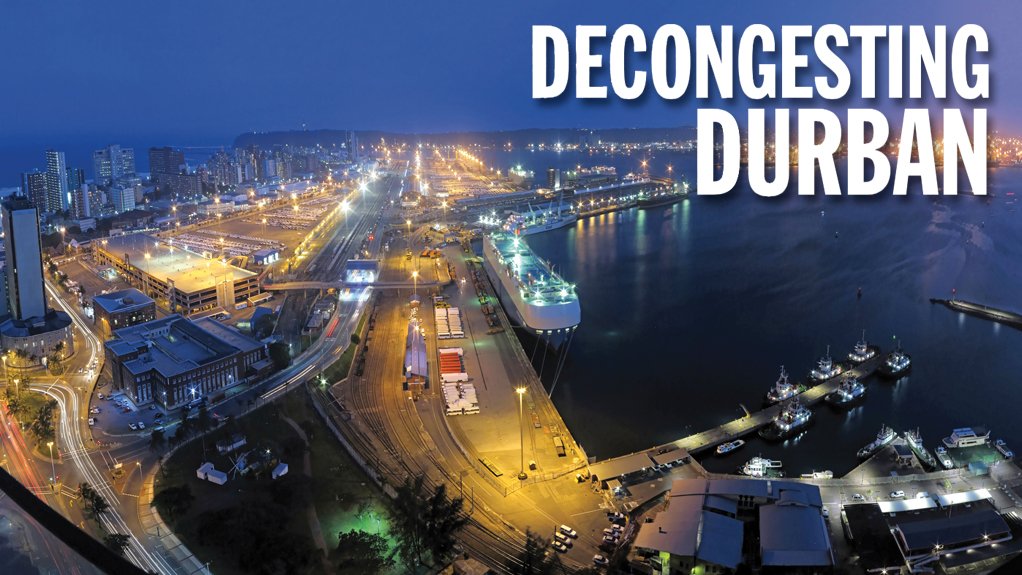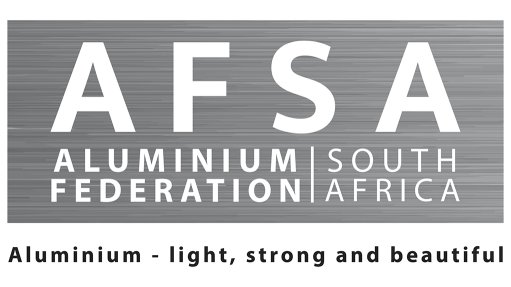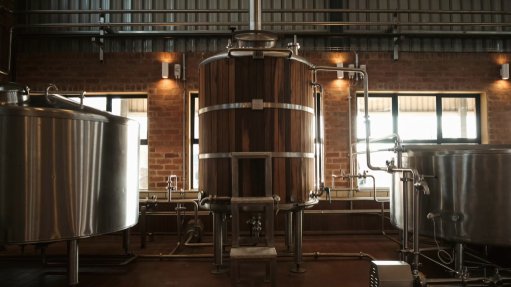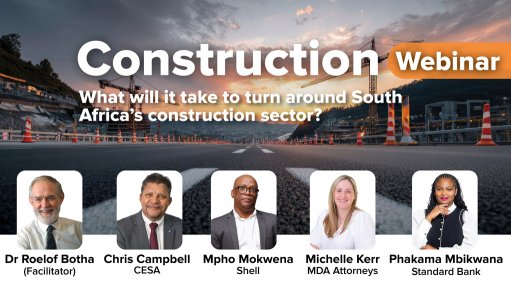Collaborative effort to unblock chronic congestion at SA’s busiest port
New equipment, improved access roads, synchronised, longer operating hours and a truck booking system are all in the works for the heavily congested Port of Durban, says Transnet National Ports Authority (TNPA) Port of Durban GM Moshe Motlohi.
The country’s busiest port has long been criticised for dragging down South Africa Inc’s productivity rather than aiding its endeavour to grow and prosper.
Reports from last year show how ships suffered heavy delays outside the port, while others were forced to bypass the facility. In the terminal itself, there were numerous go-slows by discontented staff.
In addition to this, trucks had to queue for hours along Bayhead road in lines stretching several kilometres as they waited to enter the port.
Dispatched from TNPA’s head office to deal with the problems at Durban, Motlohi says the congestion emanates from three sources.
The first source is outside Transnet – “and is thus outside Transnet’s control” – where there are challenges within secondary industries. The second source is inside Transnet and the third source the interdependence between Transnet and industry.
The project launched last year to battle chronic congestion at the Port of Durban has already reaped some rewards, notes Motlohi.
“We are not happy with where we are at the moment, but we are encouraged to see that we are starting to make a dent.”
While the queue to enter the port in August last year stretched as far as Southway Mall, which is way out of the port precinct, it was shortened to the Umbilo industrial area in September, and then to the Bayhead port entrance in December.
“This queue would affect Umbilo, access to the Bluff and other areas, meaning stakeholders who had nothing to do with the port felt the impact of what was happening there,” explains Motlohi.
By January, the queue was shortened to the Bayhead weighbridge.
“By February, truck queues were confined to the staging facility, giving everyone room to breathe,” notes Motlohi.
The Covid-19 pandemic may, however, have presented a temporary setback to the decongestion efforts, with the classification of essential cargo and nonessential cargo, and the regulations around their movement, again creating havoc at the Port of Durban.
The participants in the multidisciplinary decongestion task team include representatives from Transnet, the Department of Public Enterprises, the KwaZulu-Natal provincial government, the eThekwini municipality, the Durban Metro Police, the South African Police Service, organised business through the Durban Chamber of Commerce and Industry, the South African Association of Ship Operators and Agents and the South African Association of Freight Forwarders (SAAFF), as well as representatives from the shipping lines, the trucking industry, depot operators and other industry associations and bodies.
Integrate to Decongest
“We realised that we must integrate to decongest,” says Motlohi.
“We are in a situation where no single party is going to alleviate the congestion.
“The first thing we realised is that we needed to get all parties together to work as one team – from shipping, clearing and forwarding, the transport sector, the City of Durban, the provincial government, the Chamber of Commerce [to] individuals and employees.
“The Port of Durban contributes around 11% to [KwaZulu-Natal’s] gross domestic product, so it is quite a big player. If you look at the multiplier effect, you’ll see that many industries in the province depend on the port.”
The decongestion team meets every second week. It has identified a number of focus areas in the value chain to identify congestion challenges.
One of the problems the decongestion team is working on revolves around working hours.
Motlohi says there is a misalignment in operating hours between the container depots, warehouses and the port.
“We still see that we don’t have depots that are willing to operate 24/7.
“This immediately causes problems, as it means transporters have nowhere to drop containers after hours, which is why everybody is trying to chase the operating-hour window.
“This means the port is going to face problems when the Durban terminals are working 24/7, but the industry is working anything between 8 and 12 hours.”
Motlohi says that truck pretrip bookings for the collection and dropping off of cargo will also soon become mandatory.
“It cannot be that everyone comes to the port when they feel they have an opportunity to do so, as it causes congestion. We have finite capacity to handle X number of trucks in an hour.
“We have now reached the point where Pier 1, Pier 2, Grindrod’s depot, the FPT facilities and the bulk terminal have all indicated how many trucks they can process in an hour, and we are emphasising that nobody should just show up unannounced.”
Motlohi says Pier 2 knows that it can handle 150 trucks an hour.
What TNPA requires is for a truck to then book a slot to pick up its cargo between 08:00 and 10:00, for example, and to do so 24 hours ahead of time in order to ease congestion.
“We have started doing this in earnest, using the opportunity presented by the Covid-19 pandemic,” says Motlohi. “We are also working with the police. If the truck has no booking permit, we turn it away.”
He adds that this system has, however, presented some challenges as transporters are not used to it. (Some transporters, however, also indicate that the booking system does not work entirely as it should.)
“Some transporters just load the cargo and decide to be told their slot as they approach the port. This defeats the purpose of the booking system,” says Motlohi.
While the system is largely manual at Pier 1 at the moment, the goal is to automate the system by the end of July, as is the case at Pier 2, says Motlohi.
He also appeals to parties such as clearing and forwarding agents and cargo owners to preassign containers to transporters, even before vessels enter the port.
“It helps everybody to prepare for what is required.
“The next step in the booking system is to get the Bidvest South African Container Depot to also roll out its own booking system, because it does not help to get almost every party on board [and] still have one player out of sync.”
Truckers
Another focus area for the decongestion of the Port of Durban is to increasingly formalise truck driving operations.
Motlohi says there are a number of truck associations active in the port.
“What we are trying to do is to understand how many associations there are. We also want to know how big they are.”
Motlohi says Transnet aims to induct truck drivers into the new operations procedure at the port in a comprehensive programme being developed by the Maritime School of Excellence.
“This is being done in consultation with industry. We really think that this is going to make a significant difference. When some of the truck drivers come to port, it is clear that they do not know what to do and what not to do.”
This induction programme has, however, been delayed, owing to the Covid-19 pandemic.
TNPA is also looking at introducing a database of truck drivers, which would ensure that rogue truck drivers, or drivers suspected of working with syndicates to steal cargo, do not simply move from one cargo carrier to the next.
Inside Transnet
Motlohi says there are a number of challenges inside Transnet that the State-owned enterprise has to resolve in order to improve productivity at the Durban port.
One of these challenges is the efficiency at the terminals.
“You can optimise the processes, but if the teams’ efficiencies are substandard, then all the other hard work will be wasted,” says Motlohi.
“The fundamental focus here is to ask what levers we must pull to get the best performance.
“We believe we must bring discipline back into the teams.
“Everyone who goes to work must understand what their challenges are for today; what the expectations are from each team and each individual; how much productivity must come from each piece of equipment.
“We are clarifying and driving that to ensure that everyone knows what must be done.”
A second aspect to consider is the number of people employed at the port, says Motlohi.
“It has been a cry from industry that Pier 2 must have 14 gangs, [or work teams], and Pier 1 six.
“Transnet Port Terminals (TPT) has taken steps in this regard. When we started, we had 11 gangs – now we have 13. However, this number is dynamic. As we get new operators into the system, other people retire or leave.
“The drive is to get to 14 gangs.”
Pier 1 has five gangs, with a sixth undergoing training.
Motlohi says TPT is working with the Maritime School of Excellence to train gantry crane operators.
“However, we are mindful of the fact that too many new people in the system at once may see our operational efficiency drop again, but this should be a short-term problem.”
Motlohi says there were issues around the incentive schemes for employees at TPT and TNPA as well.
“This has been resolved. The first month of this was April. We are still to see the impact filter through.”
There was also an issue around equipment reliability as a result of a shortage of spares and the procurement contracts for the spares, adds Motlohi.
“This has been an area of focus and there is currently a better procurement process in place. This has seen spares availability, as well as the lead time between getting spares, improve tremendously.
“Before this process was introduced, the availability of equipment was on a serious downward spiral. But, yes, some equipment is old and in need of major refurbishment, but, to borrow from the Covid-19 pandemic here, we have managed to flatten the curve.”
Motlohi says Transnet has ordered new equipment for the Port of Durban.
“Twenty-three new straddle carriers were to be delivered in June, but, with the Covid-19 pandemic, these dates are somewhat of a moving target.
“Some have, however, already arrived, but this now poses a problem. The carriers were going to be assembled and signed off by expatriates, which means that we are working with government to give us a concession for these people to travel to South Africa.”
A second batch of straddle carriers is due to arrive early next year.
“This means that we could have 48 new straddle carriers injected into the system next year, if all goes well. This will certainly provide much-needed relief.
Rail
Rail as a business has lost market share not only in the broader South African economy but also at the Port of Durban, notes Motlohi.
“Chief to our problem has been the increased number of trucks to Island View. A few years ago, we had four trains a week to Island View. Now we have one train a week.”
This means that TPNA has seen an increase in the number of trucks moving bulk goods from the mines to Island View, instead of trains.
“There has been engagement between Transnet Freight Rail and the bulk terminal, and a commercial deal is almost done, where we are going to see some trains being reintroduced into the system,” says Motlohi.
He says one train will take 50 to 70 trucks off the road.
“And, while we wait for that to happen, we are pushing the bulk terminal to have its own truck booking system.”
Roads
Medium- to longer-term interventions at the Port of Durban include expanding the road capacity around the facility.
Bayhead road has long been a two-lane, bidirectional road, says Motlohi, and TNPA would like this to increase by one lane, so that it becomes a three-lane road on each side.
“Because truck volumes on that road have increased, we need to increase capacity,” says Motlohi.
“This is a project we would like to have completed by 2024.
“We are also looking at a second access road to the port. This is going to be a road that links the current port with the N2 and M7.”
“We are looking at spending R3-billion on this project, which is going to be cofunded by several State agencies, Transnet included.”
Another project is to work with law enforcement to manage traffic flows.
“We have agreed with the City of Durban that the Metro police will be deployed in key intersections around the port to assist with traffic management,” says Motlohi. “We also need those without booking permits to be turned away.”
Industry Reacts
SAAFF Harbour Carriers division chairperson Sue Moodley says the engagement sessions within the decongestion task team have been “very interactive and informative”, and that they have been enlightening “as there are many streams which contribute to the narrative, and this project is starting to take the direction it was designed for”.
“We also have recognised that the feedback provided over the weeks is being noted, and this has created much improvement to the truck booking system and the quality of reports which are being provided to the trucking industry.
“There is still much more work that needs to be done by the larger logistics community, and these gaps have been identified and highlighted to incorporate the wider logistics community,” she adds.
South African Association of Ship Operators and Agents CEO Peter Besnard says the association is “very pleased that, finally, we are beginning to see light at the end of the tunnel”.
Specialist logistics service provider OneLogix noted in February that the company had been prompted by “gross inefficiency” to move one of its businesses from the Port of Durban to Umlaas, as its “trucks can sometimes not get out of the port all day”.
“The work that the task team is doing will probably show some short-term results, but it is more of a medium-term process,” CEO Ian Lourens tells Engineering News & Mining Weekly. “You can’t turn a situation like this around overnight, because there are so many things that need to be done. We have, for example, always thought that labour is a big problem at the port. We are finding that, when there is a shift change, there is a two-hour delay. That should be 15 minutes.
“We believe it is going to take a while to resolve all the issues at the Port of Durban. It would be unrealistic to expect things to turn around overnight.”
Article Enquiry
Email Article
Save Article
Feedback
To advertise email advertising@creamermedia.co.za or click here
Comments
Press Office
Announcements
What's On
Subscribe to improve your user experience...
Option 1 (equivalent of R125 a month):
Receive a weekly copy of Creamer Media's Engineering News & Mining Weekly magazine
(print copy for those in South Africa and e-magazine for those outside of South Africa)
Receive daily email newsletters
Access to full search results
Access archive of magazine back copies
Access to Projects in Progress
Access to ONE Research Report of your choice in PDF format
Option 2 (equivalent of R375 a month):
All benefits from Option 1
PLUS
Access to Creamer Media's Research Channel Africa for ALL Research Reports, in PDF format, on various industrial and mining sectors
including Electricity; Water; Energy Transition; Hydrogen; Roads, Rail and Ports; Coal; Gold; Platinum; Battery Metals; etc.
Already a subscriber?
Forgotten your password?
Receive weekly copy of Creamer Media's Engineering News & Mining Weekly magazine (print copy for those in South Africa and e-magazine for those outside of South Africa)
➕
Recieve daily email newsletters
➕
Access to full search results
➕
Access archive of magazine back copies
➕
Access to Projects in Progress
➕
Access to ONE Research Report of your choice in PDF format
RESEARCH CHANNEL AFRICA
R4500 (equivalent of R375 a month)
SUBSCRIBEAll benefits from Option 1
➕
Access to Creamer Media's Research Channel Africa for ALL Research Reports on various industrial and mining sectors, in PDF format, including on:
Electricity
➕
Water
➕
Energy Transition
➕
Hydrogen
➕
Roads, Rail and Ports
➕
Coal
➕
Gold
➕
Platinum
➕
Battery Metals
➕
etc.
Receive all benefits from Option 1 or Option 2 delivered to numerous people at your company
➕
Multiple User names and Passwords for simultaneous log-ins
➕
Intranet integration access to all in your organisation




















